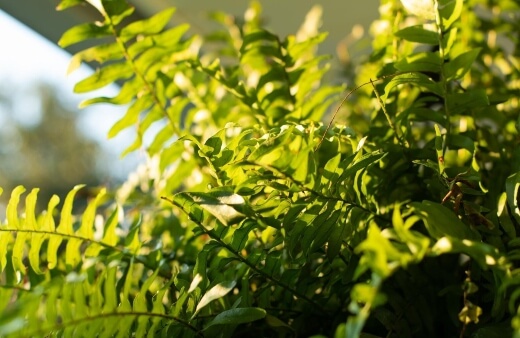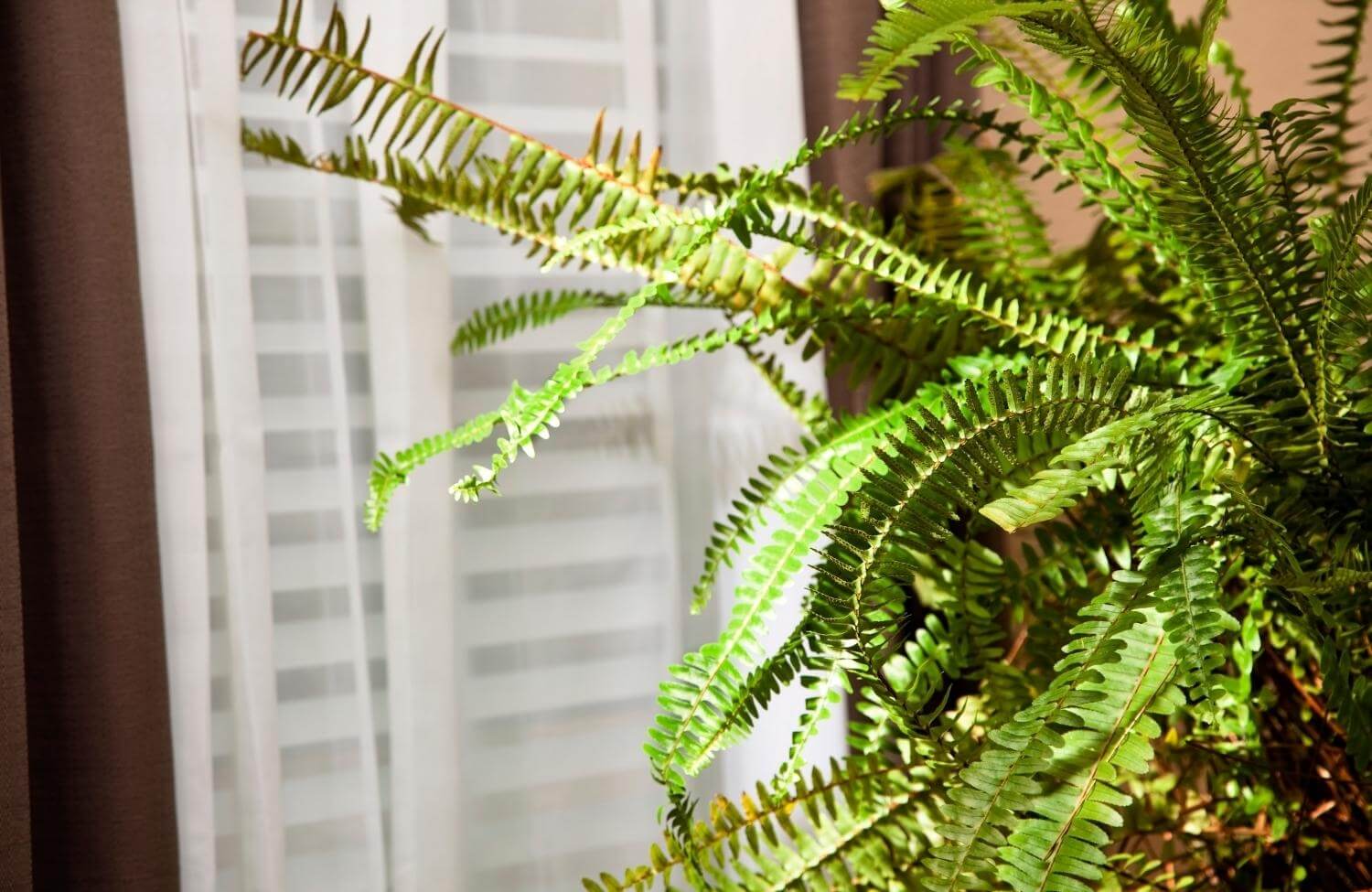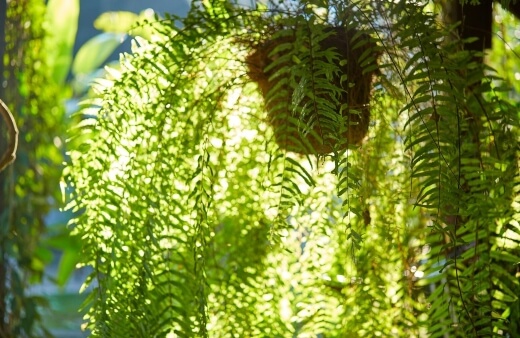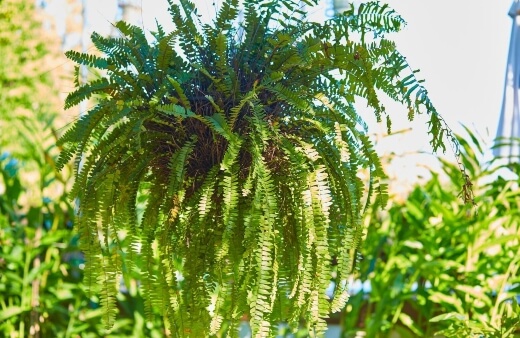Boston fern feature luscious green, sword-shaped fronds with many small leaflets that arch and drape as they grow larger. The Boston Fern is most commonly grown indoors as a houseplant where the foliage is said to have superior air cleaning qualities.
Fitting right into the Australian climate, this plant does require a little know-how but given the right growing conditions, it is easy going evergreen that doesn’t require much upkeep. Here’s how you can grow and care for your Boston Fern.
More...

Genus: | Nephrolepis |
|---|---|
Species: | N. exaltata |
Family: | Nephrolepidaceae |
Common Names: | Boston fern, Sword fern |
Location: | Indoor or outdoor |
Type: | Evergreen fern, herbaceous plant |
Growth: | 60cm to 90cm tall and wide |
Sun requirements: | Partial sun |
Foliage Colour: | Green |
Flowering: | Non-flowering |
Maintenance level: | Low |
Poisonous for pets: | Non-toxic to cats and dogs |
Boston Fern Plant Details
Native to tropical regions of the world like Asia, Africa, Central America and The West Indies, the Nephrolepis exaltata, commonly known as Boston Fern, is one of around 40 species of ferns of its genus in the Davalliaceae family.
This specific cultivar was discovered in Boston in the 19th Century and is now the most popular of its genus, being grown and admired in households worldwide.
Commonly referred to as the Sword Fern thanks to its foliage, it grows brilliantly in warm and tropical climates with high humidity so it makes for an excellent choice for most Australian plant lovers.
Growing to be roughly a metre tall and wide, the Boston Fern makes for a captivating houseplant that can brighten up any living space whether indoors or outdoors. These plants are quick to establish and are considered slow-growing like most ferns.
Requiring little maintenance, these ferns do require stable and consistent growing environments that offer the right levels of moisture and light for them to thrive. The Boston Fern is non-flowering but features luscious evergreen foliage that will impress year-round.
How to Grow the Boston Fern

Because this fern does not produce seeds, most growers choose to purchase healthy plants from reputable local nurseries and then transplant them into their desired container or garden bed.
This fern can also easily be propagated using division. In general, these ferns will thrive and grow best in environments that offer high humidity levels and consistent temperatures.
Propagating Boston Fern Using Division
The Boston Fern is easy to propagate using division and should be done while you are repotting the plant during spring. Allow the soil to get a little drier than usual before you divide the roots.
- Using a sharp, serrated knife or tool, carefully cut off a part of the donor fern with healthy roots attached.
- You can divide the root ball into two or more pieces as even smaller sections can establish themselves and grow into new plants with a little care.
- Plant your divided sections into a fresh and organic potting mix and make sure to keep the soil slightly moist at all times.
- Keep the divisions in a warm location out of direct sunlight. Also, try to keep them away from any hot or cold drafts or temperature fluctuations.
You will know your divided plants have started to take root when you feel some resistance when gently tugging at the base of the fronds.
Planting Sword Fern

Whether planted in a pot inside or planted in the garden, these ferns will require certain growing conditions to thrive. They can be fussy with moisture levels and temperature fluctuations so knowing where to place them is vital to their health. Planting should also be done in spring.
Light
The Boston Fern will grow best given bright, filtered, indirect light for at least 2 hours every day with the rest being partially shaded conditions. Too much shade will cause the fronds to grow sparsely and lose their colour where too much light will burn the foliage. Direct sunlight should be avoided as much as possible.
Best Soil for Boston Ferns
Boston ferns will grow best in slightly acidic soils that are well-draining but retain good moisture levels. If grown in the garden bed, rich and loamy soil should work great. If potted for indoor use, a peat-based, organic potting mix should be good.
Temperature & Humidity
These ferns need warm, stable temperatures and high moisture levels to thrive. They do not cope well with temperature extremes or sudden shifts in conditions.
Sudden changes in the growing environment can damage these plants. It is therefore not recommended to place them near any heating or cooling systems or near locations that get frequent drafts.
For outdoor scenarios, it is recommended to plant the Boston Fern in a sheltered position that doesn’t receive direct light and that is protected from cold winds and frost during the winter months. Ideal temperatures for outdoor use are 15°C and above year-round.
Caring for Boston Fern

Caring for the Boston Fern won’t require a lot of work as these plants are generally hardy and easy to maintain in the right conditions. They will respond well to some TLC but as long as they are in a warm and humid location out of direct light, they should grow well.
Watering Boston Fern
The Boston Fern will need regular watering to prevent the soil from drying out. Check the top 3cm of your soil using your finger to see if water is needed. The soil should be kept slightly moist at all times so if it feels dry to the touch, you can water the plant. Water at the soil level to keep the fronds dry.
Try to avoid watering with cold water as this can shock the fern’s roots. You can water Boston Ferns less frequently in the colder winter months.
Best Fertiliser for Sword fern
You can fertilise your fern between spring and autumn while the plant is actively growing. A general houseplant fertiliser at half strength given once per month during this period is recommended. Fertilise at the base of the plant.
Pruning
These plants only require light pruning as needed to keep the plant tidy and to remove any dead fronds. Hard pruning can be done to encourage new vigorous growth and to correct leggy foliage.
Humidity Control

Because the Boston Fern needs consistent high levels of humidity to thrive, you can consider aiding the plant with this if your environment is not providing enough by using a plant humidifier.
You will know your fern needs more humidity if you notice the tips of the foliage starting to brown. Regular misting Boston fern is a great way to keep them happy. You can also add a pebble tray with water underneath your container.
Alternatively, locations like the bathroom that experience higher humidity naturally can also work great for these ferns. To help with humidity levels outdoors, you can also regularly mist the fern or add some mulch to the base in summer to help keep the soil moist.
Potting & Repotting
Your containers should be well-draining and have drainage holes that are slightly larger than the plant’s root ball. As the ferns grow and the roots develop, you will need to repot the plants into bigger containers.
To start, use a container that is at least twice the size of the selected plant. Once the roots start to stick out of the soil or the plant starts to stall its growth, you can consider repotting.
Potting and repotting should be done in spring before the plant’s growing season. It is recommended to move just one container size up each time and this should allow the fern to continue developing at a healthy pace.
To pot the plant or plant it in the garden, gently remove it from its current container and replant it into your desired location at the same depth in fresh soil. Keep the soil moist at all times and the fern should establish itself reasonably fast.
Nephrolepis exaltata Pests, Problems & Diseases

Boston ferns don’t generally struggle with any major pest or disease issues so long as the growing conditions are met. However, there are a few smaller issues that you can keep a lookout for.
Dropping Fronds
If your fern starts to drop its fronds, this could indicate that your soil is too dry and you will need to water more frequently. You can cut back affected fronds to about 5cm long and they should re-sprout.
Avoid Insect Infestations
Misting the ferns regularly can also help in avoiding infestations from gnats and other small insects. While you are misting, you can wipe the leaves with a damp cloth to keep the leaves breathing sufficiently. Should you notice any insects on your fern, they can be effectively treated using neem oil or insecticidal soap.
Boston Fern Frequently Asked Questions

Do Boston ferns need sun or shade?
Boston ferns prefer bright but indirect light daily with temperatures that range from 15 to 24°C.
Will a Boston fern survive outside?
Although these ferns are predominantly grown as houseplants, they can survive outdoors in warm, humid climates with adequate moisture. Having a bird bath, garden pond or water feature nearby will help.
Temperatures should ideally stay above 15°C for outdoor applications. Frost may kill the ferns to the ground in winter but they generally rebound in spring.
Should you cut back Boston ferns?
Boston ferns respond well to light or hard pruning. This should be done in spring while you are repotting the plant. Light pruning is good to keep the ferns tidy overall.
Hard pruning where you’re cutting back large chunks of foliage can encourage prolific bushy growth and can correct dull, leggy growth. Always use clean, sharp secateurs or scissors.
Interested in growing more ferns in your home? Explore our compilation of different types of Australian ferns for your home.
Wrapping Up our Boston Fern Guide
With famed ornamental qualities in households around the world, the Boston Fern is an excellent choice for any plant lover looking for an easy to grow, low-maintenance houseplant.
They look stunning perched in tall pots, on plant stands or in hanging pots and baskets around the house where the arching, luscious evergreen foliage can complement any living space year-round.
Being a perfect pick for the Australian climate, the Boston Fern is certainly a must-have for those looking at sprucing up their plant collections.

Published on March 31, 2022 by Maisie Blevins
Last Updated on February 26, 2024





Hi there.
I need your advice and hoping you can help. Just enquiring if indoor (sheltered outdoor balcony actually) Boston Ferns growing in Brisbane can thrive using 2 hours of LED lights a day. I have four Bostons that are rangey (leggy without bushy undergrowth and dropping leaves) at the base presumably because of insufficient light.
They live in inner city Brisbane on an outdoor balcony facing East ( we only get around 60/90 mins of hard hitting sun in the morning (too much for a Boston so I bring mine inside unril the sun abates) and return them outside for the rest of the day …. the lighting is mediocre and indirect.
As they only need 2 hours of indirect light a day wondering if introducing low lighting LEDs at night time (if thats an option.. what LED wattage would be enough and not OTP) might be a way of getting them to look bushy and healthy like the Bostons on your website. Any advice would be appreciated.
Thanks ..
Jules
Hi Jules,
Boston ferns actually need a fair bit of indirect light to develop. They are not like other ferns in that way. While it sounds like the morning sun might be too strong, moving them in and out of the house every day probably means they are missing the light they need.
Have you ever left them outdoors in the morning sun? I’d be interested to know how it affects them, because you could maybe create a slatted shade rather than bringing them in.
Fern houses use the technique really well, and essentially it’s just taking into account that ferns, while preferring part shade and dappled light, do actually need light (just less of it). Ideally, they should have 6-8 hours of dappled or filtered light, rather than 2 hours of direct light.
Maybe play a round with their routine a little bit, and test out how they go in the morning sun for a few days (obviously remember to water them too!). If they don’t crisp up, they should fill out and become much bushier within a month or two. Good luck.
Best regards,
Maisie Blevins